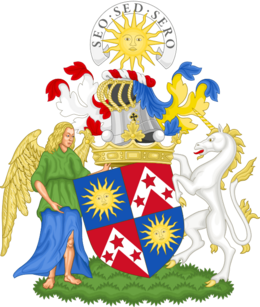Clan Kerr facts for kids
Quick facts for kids Clan Kerr |
|||
|---|---|---|---|
| Cearr, MacGhillechearr | |||

Crest: The sun in his splendour Or
|
|||
| Motto | Sero sed serio (Late but in earnest) | ||
| Slogan | Late but in Earnest | ||
| Profile | |||
| District | Scottish Borders | ||
| Plant badge | Bog Myrtle | ||
| Chief | |||
 |
|||
| The Most Hon. Michael Kerr | |||
| The 13th Marquess of Lothian | |||
| Seat | Ferniehirst Castle | ||
|
|||
|
|||
|
|||
|
|||
Clan Kerr is a famous Scottish clan from the Scottish Borders. For many years, it was one of the most important "border reiver" clans. These clans lived along the border between Scotland and England. They played a big part in the history of the Scottish Border country.
Contents
History of Clan Kerr
Where the Kerr Name Comes From
The name Kerr can be spelled in different ways. Some examples are Kerr, Ker, Carr, and Carre. The name comes from an old Norse word, kjarr. This word means "marsh dweller." It came to Scotland from Normandy, a part of France.
Another meaning for the name comes from the Scottish Gaelic word ciar. This means "dusky" or "dark." This version is found on the west coast of Scotland.
The first Kerrs in Roxburghshire lived in the 1100s. They came from a place called Cunninghame in Ayrshire. A powerful Scottish leader, Hugh de Morville, gave land to William de Ker. This land became known as Kersland.
Early Kerrs and Scottish Independence
William de Ker's grandson was a friend of William Wallace. Wallace was a hero who fought for Scottish independence. William Ker of Kersland joined Wallace in 1296. He was a constant friend and fought alongside Wallace. Sadly, William Ker was killed in 1305. This happened when Wallace was captured.
The main Kerr families believe their ancestors came from Normandy. Two brothers, Ralph and Robert, came to Roxburgh. The Kerrs of Ferniehurst came from Ralph. The Kerrs of Cessford came from Robert. These two families were often rivals.
Kerr Family Conflicts (1400s-1500s)
The two main branches of Clan Kerr often fought each other. These were the Kerrs of Ferniehurst and the Kerrs of Cessford. However, both families also held important jobs. They were "Wardens of the Middle Marches." This meant they protected the border.
After the Battle of Flodden in 1513, some clans asked the Kerr of Ferniehurst for protection. In 1523, English forces captured his castle. But the Kerrs defended it bravely.
The Clan Kerr had a big feud with the Clan Scott. This fight started in 1526. Sir Walter Scott of Buccleuch tried to rescue young King James V of Scotland. The king was being held by the Douglas family. During the fight, Kerr of Cessford was killed.
Years later, in 1552, the Kerrs got their revenge. They attacked Sir Walter Scott in Edinburgh and killed him. The feud finally ended when Sir Thomas Kerr of Ferniehirst married Janet Scott. She was the sister of the Scott chief.
Kerrs in the 1600s and Civil War
In 1606, Mark Kerr became the Earl of Lothian. Later, in 1621, Sir Andrew Kerr of Ferniehurst became Lord Jedburgh.
Another important title was the earldom of Ancram. This went to Sir Robert Kerr. In 1616, Sir Robert Ker of Cessford became Earl of Roxburghe. In 1631, Sir William Kerr was made a new Earl of Lothian. His son, Robert Kerr, later became a Marquess.
During the Scottish Civil War, Colonel Kerr supported the Covenanters. These were Scottish Protestants. He helped General David Leslie, Lord Newark. Colonel Kerr captured and destroyed Redcastle.
Kerrs in the 1700s and Jacobite Risings
Lord Mark Kerr was a skilled soldier. He was known for being honorable and quick-tempered. He fought in many duels. He became a general and was in charge of Edinburgh Castle in 1745.
During the Jacobite rising of 1745, Clan Kerr supported the British government. At the Battle of Culloden in 1746, Lord Robert Kerr fought bravely. He was a captain in the army. He was the only high-ranking officer killed on the government side.
Lord Mark Kerr, who later became the 4th Marquess of Lothian, also fought at Culloden. He led three groups of government cavalry. He survived the battle.
Left-handedness and the Kerrs
The Kerr family has often been linked to left-handedness. Some of their castles, like Ferniehirst Castle, have special stairs. These "turnpike stairs" were built to help left-handed people fight better.
Andrew Ker (1471–1545) was known as Dand. He made Ferniehirst Castle very strong. Both Dand and his grandfather were believed to be left-handed swordsmen. A left-handed fighter could earn more money. People fighting for the Kerrs were even encouraged to fight "ker-handed."
There's a story that many Kerrs are left-handed. A study in 1972 said about 30% of people with the surname Kerr were left-handed. This was much higher than the average. However, a later study in 1993 did not find this to be true.
Kerr Castles
The Clan Kerr has owned several important castles.
- Ferniehirst Castle is near Jedburgh in the Scottish Borders. It is an old tower house that has been changed over time. The castle was first built in 1470. The Kerrs of Ferniehurst were made Wardens of the Middle Marches in 1502. The castle has a special "Left-Handed Staircase." This staircase was supposedly designed for Sir Andrew Kerr. He was left-handed and trained his followers to fight with their left hands.
The English attacked Ferniehirst Castle in 1523. But it was taken back in 1549 with help from the French. In 1570, the castle was damaged again. This happened when Sir Thomas Kerr tried to help Mary, Queen of Scots. In 1593, King James VI of Scotland attacked the castle. This was because the Kerrs helped someone the king accused of treason.
Today, the Kerr Marquises of Lothian still own Ferniehirst Castle. It is open to the public in July. People say a "Green Lady" ghost haunts the castle.
- Newbattle Abbey is near Dalkeith in Midlothian. After the Protestant Reformation, the Kerrs of Ferniehirst received this property. They became Lords of Newbattle in 1591 and Earls of Lothian in 1606. The feud between the Ferniehirst and Cessford Kerrs ended in 1631. This was when William Kerr of Ferniehirst married Ann Kerr of Cessford. The family became Marquises of Lothian in 1701.
Many old buildings at Newbattle were taken down. But some were used to build a strong home for the family. It was later changed into a large mansion. The 11th Marquis of Lothian gave the building to Scotland. It is now a college. Some say a "Grey Lady" ghost haunts the castle. There are also stories of ghost monks.
- Cessford Castle is a large, ruined castle. It dates back to the 1400s or earlier. The Kerrs of Cessford held this castle. They were rivals of the Kerrs of Ferniehirst. Sir Andrew Kerr of Cessford fought at the Battle of Flodden in 1513. Cessford Castle was attacked by the English in 1519. It was thought to be the third strongest castle in Scotland.
The castle was burned in 1543 and attacked again in 1544. Sir Walter Kerr of Cessford was sent to France. This was because he was involved in the killing of Walter Scott of Branxholme and Buccleuch. The Kerrs of Cessford became Earls in 1616. Then they became Dukes of Roxburghe in 1704. Around 1650, Cessford Castle was left empty. Its stones were used to build Floors Castle.
- Floors Castle is a huge mansion that looks like a castle. It was built in 1721. It was designed by William Adam. It was later changed by William Henry Playfair in the 1800s.
Clan Chief
- The current chief of Clan Kerr is Michael Andrew Foster Jude Kerr, 13th Marquess of Lothian.
- The clan's coat of arms shows a sun and three stars on a silver background.
Clan Crest and Motto
The Kerr family crest has the Latin motto 'Sero Sed Serio'. This means "late, but in earnest." The crest also shows an image of the sun.
The motto was chosen after the Battle of Ancrum Moor in 1545. This battle happened near Ferniehirst Castle. During this time, clans often changed sides to survive. In this battle, the Kerrs first sided with the English. But when the Scots started winning, the Kerrs switched sides. They attacked the English, who had the low winter sun in their eyes. The Kerrs arrived "late, but in earnest" and helped the Scots win.
Kerr Tartans
Clan Kerr has three official tartans:
- Kerr (Modern)
- Kerr (Hunting)
- Kerr (Muted)
Images for kids





